Introduction
Poison ivy (Toxicodendron radicans) is an allergenic plant of the cashew family native to North America. Poison ivy and the closely related plants poison oak (Toxicodendron toxicarium) and poison sumac (Toxicodendron vernix) all grow in Florida and contain the oily resin called urushiol. A guide to identification of these species is available in the article Identification of Poison Ivy, Poison Oak, Poison Sumac, and Poison Wood. This EDIS publication is intended to aid landowners, gardeners, horticulturalists, and pest management professionals in identification and management of poison ivy in residential and commercial landscapes.
Species Description
Class
Dicotyledon
Family
Anacardiaceae (Cashew family)
Other common names
Eastern poison ivy
Life Span
Perennial growing vine or woody shrub
Habitat
Poison ivy is native to Florida and grows best in fertile, moist, and well-drained soil. It is often found in fields, pastures, farms, home landscapes, and woodland areas. As a vine, it can climb along fences and buildings, or it may attach itself to shrubs, trees, or other structures (Figure 1).
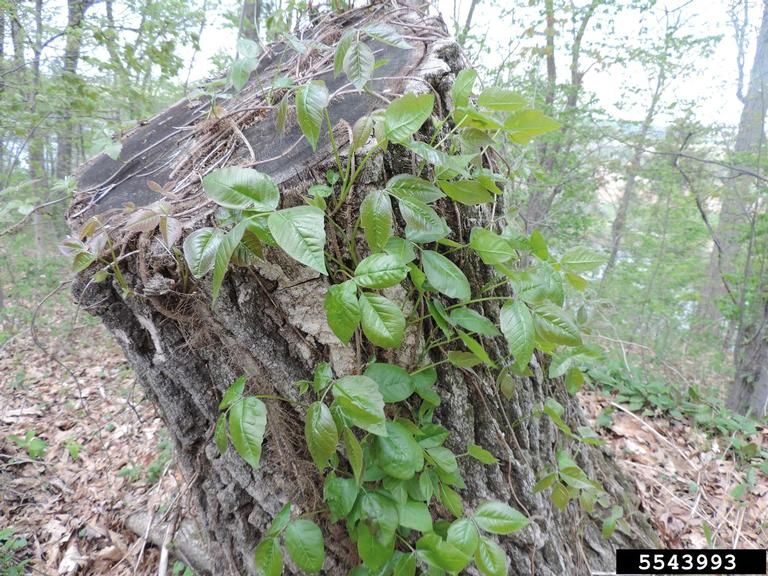
Credit: Richard Gardner, Bugwood.org
Distribution
Poison ivy is native to North America, found from Maine to Florida and westward from Nebraska to Texas (USDA-NRCS 2019). It is widely distributed through all the counties in Florida (Wunderlin et al. 2019). It can also be found throughout southern Canada, Mexico, Japan, and central China.
Growth Habit
Poison ivy can grow as a woody shrub or an erect vine that climbs on trees, fences, and walls with the help of its aerial roots (Figure 1).
Seedling
Seedlings first emerge with 2 cotyledon leaves, with 3 parted leaves appearing next. The cotyledon is light green with narrow, oblong-shaped leaves (Figure 2).
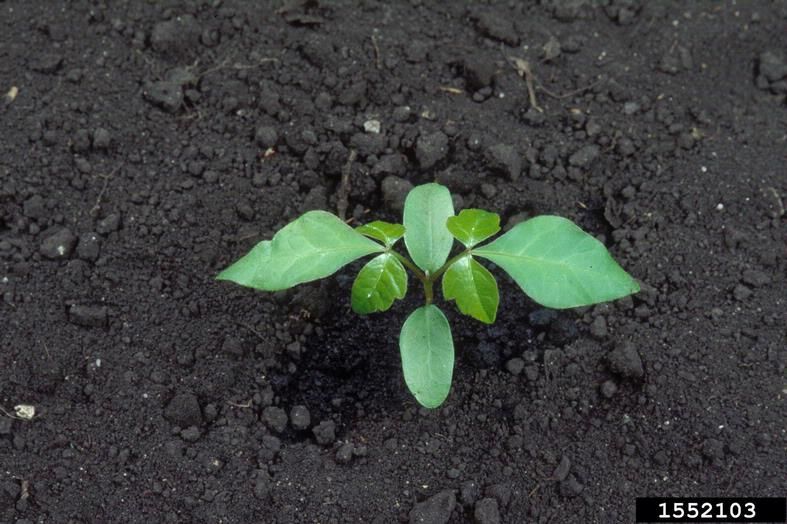
Credit: Ohio State Weed Lab, The Ohio State University, Bugwood.org
Shoots
The stems can be woody, growing up to 72 inches in height, or a vine that can climb trees, walls and other structures, up to 150 feet in length. The stems are smooth and light brown to gray in color. Leaves are alternate and compound, consisting of three leaflets that vary greatly in shape (Figure 3). The leaves may be hairless and smooth or hairy and toothed on edge. Young leaves are often tinted with red, and the mature leaves change from dark green to red, orange, or yellow in the fall (Figure 4). The leaflets grow 2 to 6 inches long and 1 to 6 inches wide.
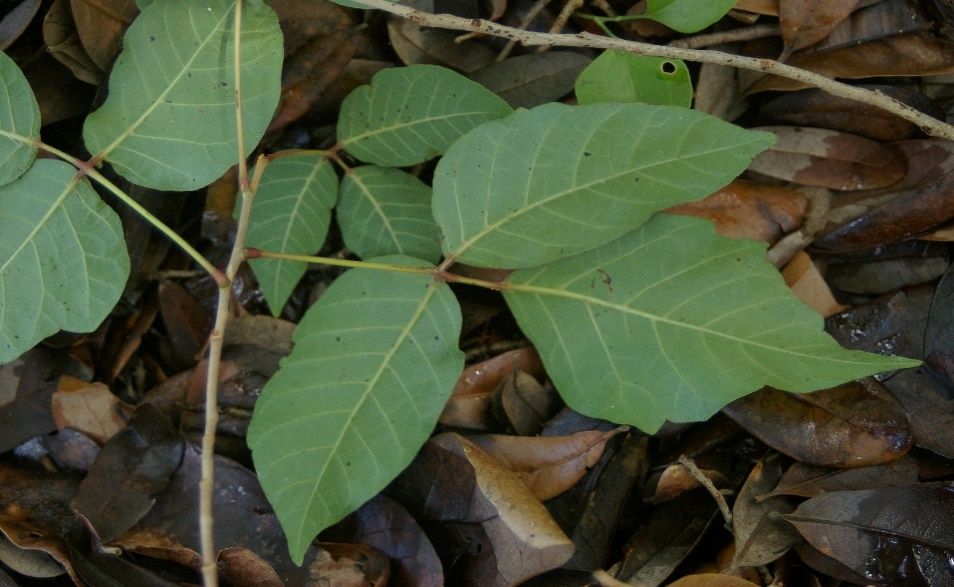
Credit: Annette Chandler, UF/IFAS
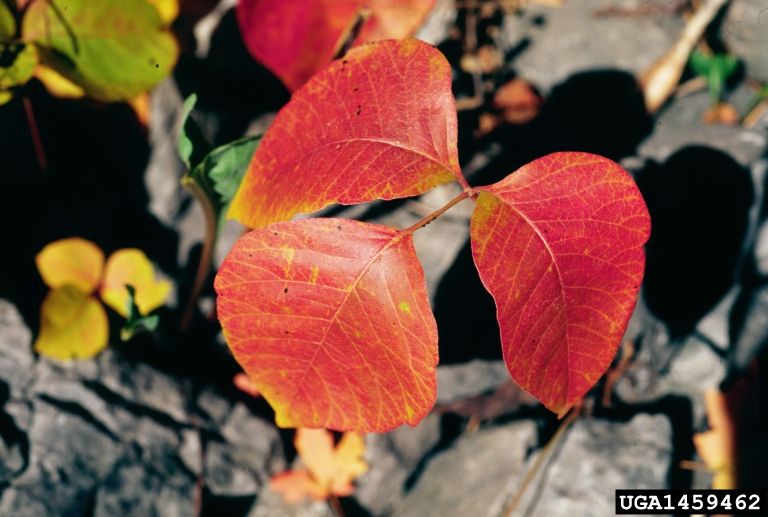
Credit: Steve Dewey, Utah State University, Bugwood.org
Roots
Poison ivy has a fibrous root system. The vines develop adventitious roots to climb and spread. The plant can also spread through rhizomes (underground stems) and root crowns.
Inflorescence
The flowers are formed in clusters on the stem that originate in the axis of the leaves along the sides of the smaller branches. The flowers are small and form a cluster of six or more. The flowers are yellowish green in color, round, and formed in a cluster 1 to 3 inches long (Figure 5). In Florida, poison ivy starts flowering from late March through September.
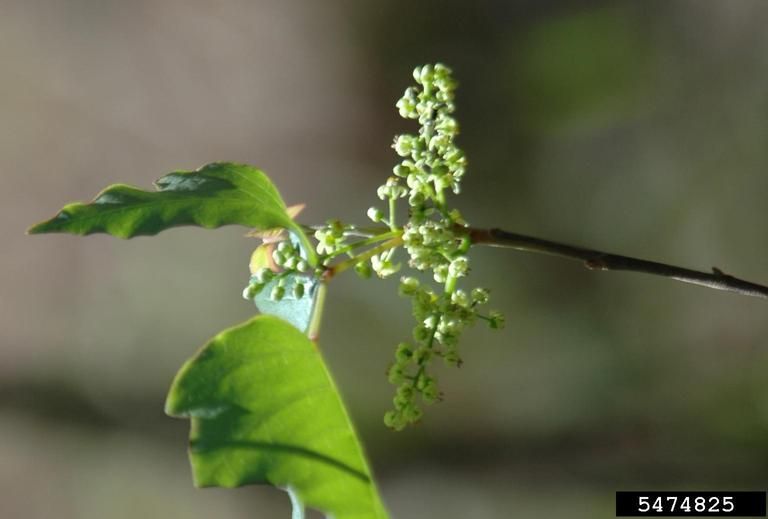
Credit: Karan A. Rawlins, University of Georgia, Bugwood.org
Fruits and Seeds
The fruit grows in clusters on slender stems between the leaves and woody stem (Figure 6). The fruit is grayish white to yellow in color, round, and textured with a waxy coating (Brown 2015). Not all poison ivy plants produce fruits, because male and female flowers are on separate plants. The seeds are grayish in color and about 1/8 inch in diameter. The fruits are a source of food for numerous birds and mammals, which digest the fleshy part and excrete the seeds. Seeds are commonly dispersed through birds, mammals, and water.
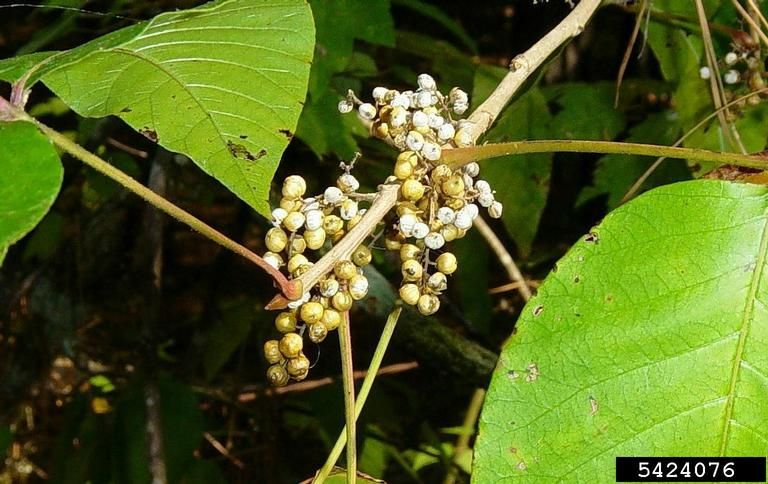
Credit: Franklin Bonner, USFS (ret.), Bugwood.org
Similar Species
Poison ivy is commonly confused with Virginia creeper (Parthenocissus quinquefolia). Virginia creeper has 5 to 7 leaflets and toothed (serrated) margins distinguishing it from poison ivy (Figure 7). Other features that distinguish it from poison ivy are the blue-black berrylike fruit and the presence of tendrils used by the plant to attach to trees and other surfaces (Figure 8). The seedlings of box elder tree (Acer negundo) also look similar to poison ivy. Box elder seedlings often have three to five leaflets, but they can be distinguished by the placement of the leaves. The leaves in poison ivy are alternate, whereas box elder has opposite leaves (leaf stalk on the opposite side) (Hill and Tenney 2020). Box elder also lacks hairy aerial roots, and it does not produce any berries.
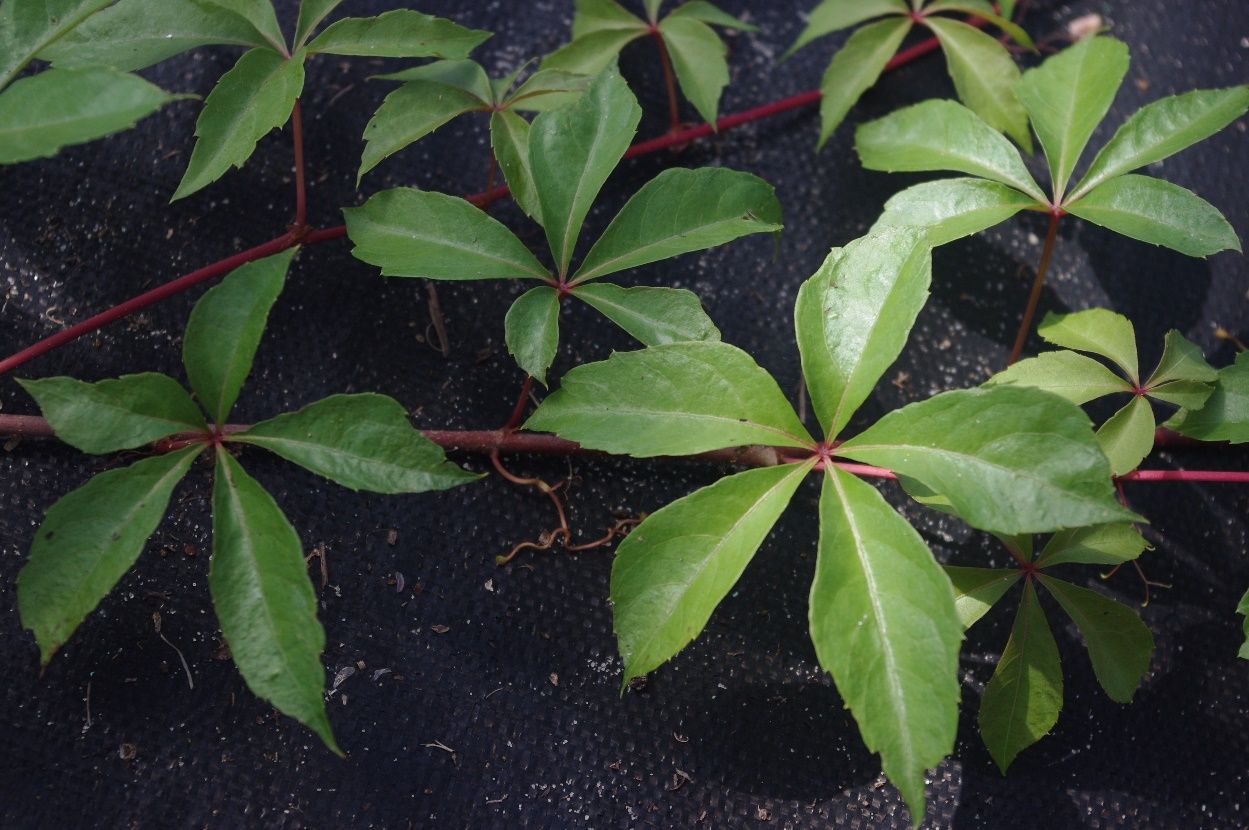
Credit: Annette Chandler, UF/IFAS
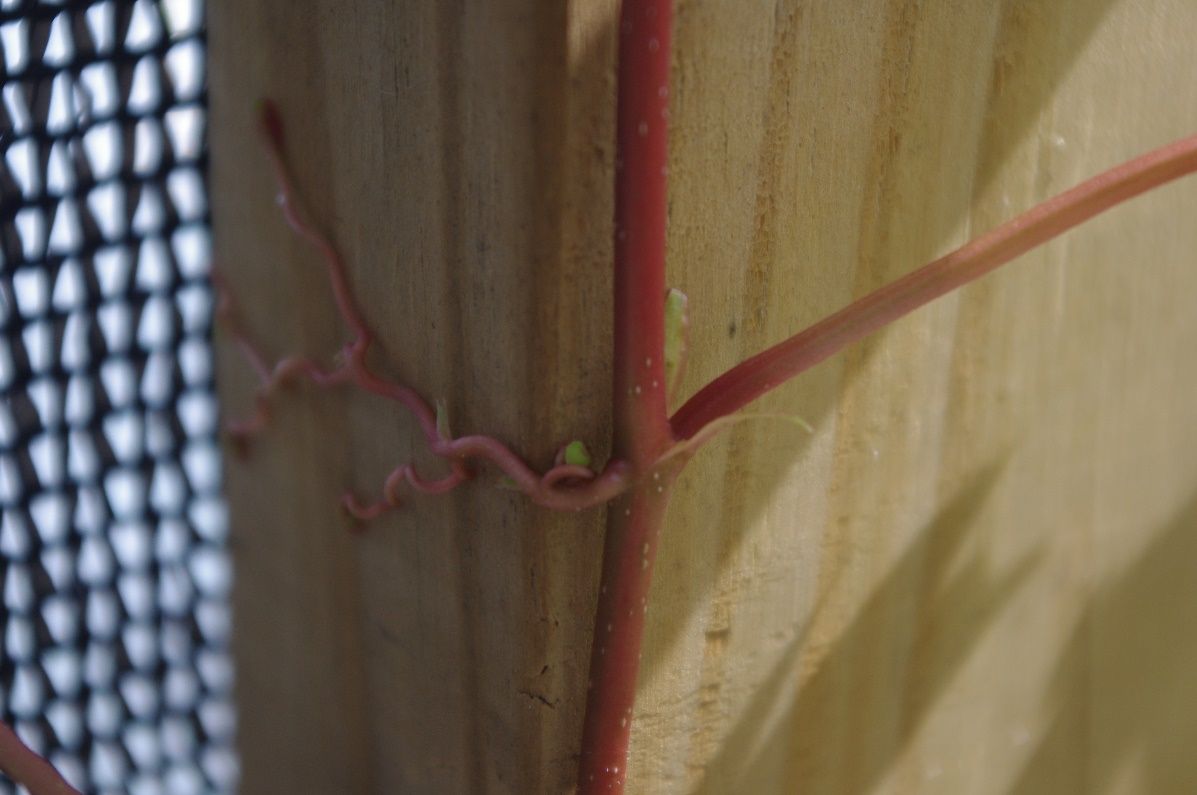
Credit: Annette Chandler, UF/IFAS
Other species related to poison ivy are poison oak (Toxicodendron diversilobum), poison sumac (Toxicodendron vernix) and Florida poisontree, all of which are native to Florida. Each contains the toxic oil responsible for poison ivy–like allergic reactions. Information on detailed identification of the following species can be found at https://edis.ifas.ufl.edu/publication/EP220. Poison ivy relatives that grow in Florida such as mango (Mangifera indica) (https://edis.ifas.ufl.edu/publication/MG216), cashew (Anacardium occidentale) (https://edis.ifas.ufl.edu/publication/HS377), and the highly invasive Brazilian peppertree (Schinus terebinthifolius) (https://edis.ifas.ufl.edu/publication/AA219) may also cause allergic reactions in some individuals.
Plant Biology
Poison ivy can tolerate a wide range of soil conditions and has been observed growing in clay, silt, loam, and sandy soils (Brockway et al. 2009). The seeds germinate in mid-to-late spring in Florida and are viable for up to six years. Poison ivy can grow in both sunny and shaded locations but prefers shaded areas. Poison ivy contains an oily resin called urushiol, which causes skin rashes when people come in contact with it (Hill and Tenney 2020). Urushiol is present in all parts of the plants, including its aerial roots, dried leaves, and fruits. This allergic reaction can also occur indirectly if the oil has been in contact with an animal, tools, clothes, or shoes. The smoke from the burning poison ivy can cause lung irritation and nasal passages. The oil is toxic all year, but the severity of the allergic reaction varies depending on the time of year, condition of the plant, and individual sensitivity.
Management
Physical and Cultural Control
Small seedlings can be carefully pulled out with the use of gloves and protective clothing (long sleeves, long pants, etc.). If the plant is mature with a well-established root system, hand pulling will be very difficult if not impossible. Poison ivy can grow back from the fragments left in the ground. However, if the plant is small, removing the entire plant including roots and stems can be effective. Mechanical control such as regular mowing or tillage can be effective. Repeatedly cutting vines at the soil line can eventually provide control over several years.
Chemical Control
The most common herbicide used for poison ivy control in the landscape is glyphosate. It can be used as a directed spray around other plants at a 2% spray solution with water. If the vines are very large, it can be applied in combination with cutting the stems. To treat stems individually (such as those growing on other plants), the stem should be cut and can then be immediately treated (“painted”) with a product that contains 41% glyphosate, either at full strength (no dilution) or diluted to a 50% mixture with water, following the label directions for cut-stump treatments.
Herbicides marketed as “poison ivy killer” are sold by many different manufacturers for homeowners and may contain different active ingredients, but these products commonly include some combination of glyphosate, triclopyr, 2,4-D, or dicamba. The homeowner products are typically ready-to-use or sold at a low concentration of active ingredient. All of these herbicides can be effective, but they can also cause injury to other plants (especially broadleaf plants) if misapplied, so the user should use extreme caution. Herbicides that contain triclopyr, 2,4-D, or dicamba are not labeled for use in landscape planting beds. In this situation, glyphosate can be used in addition to many other nonselective glyphosate alternatives. Nonselective alternatives such as glufosinate (Finale), diquat (Reward), and pelargonic acid (Scythe) can work on small plants and will defoliate large plants, but because they are not translocated, they are typically ineffective at completely eliminating large established poison ivy plants. For more information on glyphosate alternatives, refer to Use of Glyphosate and Herbicide Alternatives for Weed Control in Florida Landscape Planting Beds.
References
Brown, S. P. 2015. Identification of Poison Ivy, Poison Oak, Poison Sumac, and Poisonwood. ENH886. Gainesville: University of Florida Institute of Food and Agricultural Sciences. Accessed 5 May 2020. https://edis.ifas.ufl.edu/publication/EP220
Brockway, D. G., K. W. Outcalt, B. L. Estes, and R. B. Rummer. 2009. “Vegetation Response to Midstorey Mulching and Prescribed Burning for Wildfire Hazard Reduction and Longleaf Pine (Pinus palustris Mill.) Ecosystem Restoration.” Forestry 82 (3): 299–314. https://doi.org/10.1093/forestry/cpp010
Hill, E., and A. Tenney. 2020. Poison Ivy in Michigan. Michigan State University Extension Bulletin E3438. https://www.canr.msu.edu/pestid/resources/plant-and-weed-identification/PoisonIvy_E3438_AA%20(002).pdf
USDA-NRCS. 2019. Toxicodendron radicans (Poison ivy). https://plants.usda.gov/core/profile?symbol=TORA2
Wunderlin, R. P., B. F. Hansen, A. R. Franck, and F. B. Essig. 2019. “Atlas of Florida Plants.” Accessed May 4, 2020.https://florida.plantatlas.usf.edu/Plant.aspx?id=3476